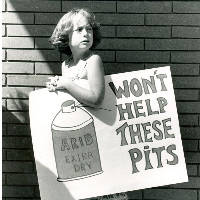State’s $60 Million Stringfellow Acid Pits Win in High Court Could Cost Insurers Billions

The Stringfellow waste disposal facility operated in Riverside County for 16 years, from 1956-1972, before it was determined that the former quarry made a poor toxic dump.
The “acid pits” have been litigated over ever since.
Last week, the California Supreme Court unanimously ruled that seven insurance companies who issued multiple policies spanning different time periods were liable for the policies’ full face values, not varying percentages. It is estimated that California, which took possession of the 17-acre Super Fund site after its owner walked away from mounting cleanup costs, could net $60 million plus interest from the court decision.
The state has battled with insurers for years over who pays for what could amount to $700 million in cleanup bills. Insurers have already paid $120 million. Underlying much of the debate over liability was the legal debate over how to treat a disaster that is spread across a broad time frame.
The court’s unambiguous ruling—“If an occurrence is continuous across two or more policy periods, the insured has paid two or more premiums and can recover up to the combined total of the policy limits” written by Justice Ming Chin—could have implications for other liability cases, like water pollution and asbestos.
The ruling “cements California's reputation as a paradise for policyholders,” Rene L. Siemens, a lawyer who represents manufacturers, told the Los Angeles Times. He called it the “most important insurance coverage decision in a decade” and said it could cost insurance companies billions.
More than 34 million gallons of liquid industrial waste were dumped in the acid pits during its years of operation. Contamination from the site leached into groundwater and spread for miles through the Jurupa Valley, forcing closure of private drinking water wells.
And then it got ugly.
Heavy rains in 1969 and late ‘70s caused overflows in evaporation ponds that polluted the surrounding area. Runoff inundated a local school. Children played in it and then watched as their clothing disintegrated later. The U.S. Environmental Protection Agency (EPA) put Stringfellow on its National Priorities List in 1983 and named it a Superfund site. Eventually a clay cap was put on the site to prevent further runoff.
Testing has revealed groundwater pollution that includes volatile organic compounds (VOCs), perchlorate and heavy metals such as cadmium, nickel, chromium and manganese. The soil is contaminated with pesticides, polychlorinated biphenyls (PCBs), sulfates, perchlorate and heavy metals.
The EPA says Stringfellow potentially affects the Chino III ground water basin which is used for industrial and agricultural purposes and supplies drinking water for approximately 40,000 residents.
A federal court held the state liable in 1996 and it assumed responsibility for the site in 2001. Much of the cleanup is complete, but ongoing extraction and treatment of contaminated groundwater continues. Perchlorate, a salt used in solid rocket fuels, was found in groundwater in 2001.
–Ken Broder
To Learn More:
State Prevails in Stringfellow Toxic Payment Suit (by Janet Zimmerman, Riverside Press-Enterprise)
Insurance Firms Lose Fight over Stringfellow Cleanup (by Maura Dolan, Los Angeles Times)
State Supreme Court Rules Against Insurers in Stringfellow Acid Pits Case (by Cheryl Miller, The Recorder)
California Wins Big Insurance Case (by Bob Egelko, San Francisco Chronicle)
California v. Continental Insurance (California Supreme Court) (pdf)
Stringfellow (U.S. Environmental Protection Agency)
- Top Stories
- Controversies
- Where is the Money Going?
- California and the Nation
- Appointments and Resignations
- Unusual News
- Latest News
- California Forbids U.S. Immigration Agents from Pretending to be Police
- California Lawmakers Urged to Strip “Self-Dealing” Tax Board of Its Duties
- Big Oil’s Grip on California
- Santa Cruz Police See Homeland Security Betrayal in Use of Gang Roundup as Cover for Immigration Raid
- Oil Companies Face Deadline to Stop Polluting California Groundwater





